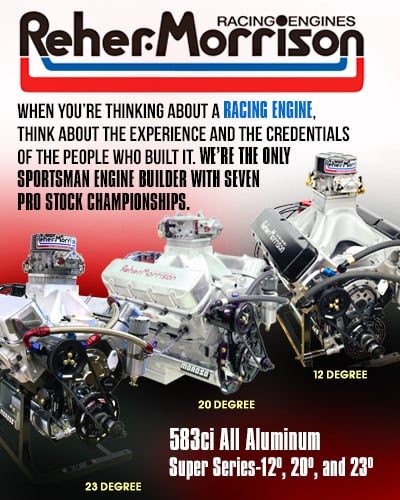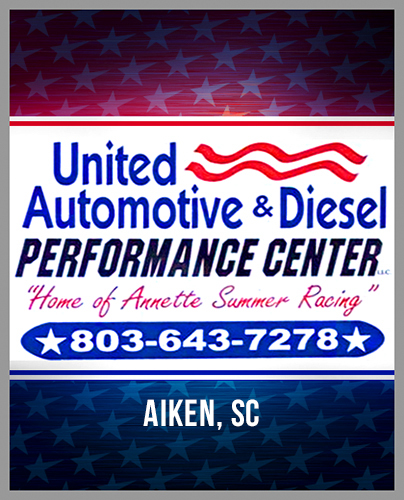REMEMBERING THE DAYS WHEN PRO GAS INSPIRED A TRANSFORMATION OF SPORTSMAN DRAG RACING

The light flashes green, and the wheels are up off the line. They are side-by-side down the dragstrip until the AMX pulls ahead at the stripe, recording a 9.90-second elapsed time at 130 miles per hour. No, this was not Modified Eliminator class eliminations. It was, instead, just one of the early racing in Super Gas racing.
There was little to no electronics in these earlier days, and using nothing more than a mechanical throttle stop was the name of the game when this trend started to make its way to the national event scene of drag racing.
Don Meziere, the driving force behind Meziere Enterprises, had a front-row seat to the birth of this drag racing format. Before 9.90 racing became Super Gas, it was Pro Gas. It also ran on a 9.50 or 9.80, depending on where you raced in California.
"It's hard to recapture the past," Meziere said. "We all look back to the nostalgia days, and it was a ton of fun. We actually started getting involved in that in 1980. SoCal Pro-Gas was going for a couple of years before that, and we could see that it was really going to take off. It was fascinating cars, all kinds of different body styles, and a really good mix of people and very competitive."
Pro Gas's roots can be traced back to the early 1970s, when an impromptu eight-car event at Redding Dragway in Redding, CA., ran what is considered today to be West Coast Pro Modifieds on a 9.50 index. In the southern part of the state, tracks such as Orange County International Raceway began running similar shows, albeit on a 9.80 index.
At a time when bracket racing was working to offer an economical alternative to class racing, Pro Gas presented a way for bracket racers to race heads-up.
Meziere was only 12 when he watched his brother Dave enter the Pro Gas arena with a '62 Corvette he'd traded his 1927 Ford T roadster for.
In those days, one had to run all out just to hit the 9.80 index essentially.
"In the first SoCal Pro-Gas race he went to, the car would just barely run fast enough with a small block, but it was good enough, it would run it," Meziere recalled.
Unlike many of the finely refined chassis under the class cars, the new kids on the block in Pro Gas presented just enough to get by.
"The car was rough, man," Meziere explained. "It had a fence pipe roll cage in it and stuff like that. It was pretty bad. It would never fly in today's NHRA, but that was what we did back then. The cars were a little crude, but immediately that car got a chassis under it and a real roll cage and all of that. He actually built it initially with a ladder bar, and then shortly after that, put a four-link in it because he could see how that was.
"And kind of the same time, people were starting to play around with trans brakes, and because Pro-Gas, they had a big vote among all the drivers one day, and they decided on the short tree, on the pro tree, which wasn't very well accepted at the time. Immediately, it became important to have a car that really launched well. We didn't have transbrakes. The first thing was the Lamb brake with the drum on the back of the transmission."
For those wondering what a Lamb brake was. There was a drum on the back, on the output of the transmission, and a band applied. It was technology created by suspension specialist Roger Lamb.
VIDEO - SEE WHAT SUPER GAS USED TO BE
 While some of the racers in Southern California, such as Meziere, were doing all they could to reach the 9.80 index, it was those Nor-Cal racers who were their most prominent critics in trying to get the index moved to a universal 9.50 index.
While some of the racers in Southern California, such as Meziere, were doing all they could to reach the 9.80 index, it was those Nor-Cal racers who were their most prominent critics in trying to get the index moved to a universal 9.50 index.
Often, the cries of "9.80s is for little old ladies" made their way around the pits.
"That would get under people's skin a little bit in So-Cal," Meziere said. "Who knows why we latched onto these things? I think they looked at all the cars that they had running at the time and who could run it and try to gather in as many people. But it was a hot topic: who was going to choose which index?
"Bringing the two associations together was always a problem then, too; if you wanted to meet in the middle at Bakersfield or something like that, whose index are you going to run on? Well, usually, they had to slow down for the SoCal guys. I think that is the way that usually went. But we actually sponsored some races in the early '80s, and we call them outlaw races, where we would take the SoCal Pro-Gas Association and challenge them to run on the 9.50 index."
These taunts led to introducing nitrous oxide in some combinations to speed them up. Eventually, the racers found ways to build more powerful motors, with the challenge of slowing them down.
"There were some cars that were just short of the index, and they knew it going into it, and everybody else knew it too, so they would just get covered up pretty easy," Meziere explained. "But many of the cars only had an extra .05, a .10, and they would put a bolt under the carburetor or a bolt under the accelerator pedal and tune it.
"My brother did that for a while, but then he started moving weight in and out of the back of the car, thinking that was a little more reliable. I think that was right. He had a good seat-of-the-pants feel for the car, too. He ran a three-speed transmission. Most people ran the Powerglide, but if he felt like the car didn't move as hard as it should have, he would run the two, three shift out another 200 or 300 RPM and pick back up what he thought the car lost."
Meziere believed the good drivers always found a way to get to the top, naming Sheldon Gecker and Arthur Joe Covert as two examples. Outside of California, Ohio presented likely the most challenging drivers in the early days of Pro Gas.
The leading magazines of the era, Super Stock & Drag Illustrated and Popular Hot Rodding, featured this new drag racing style on their covers. This growing popularity and the IHRA's new Hot Rod version (10.50) led to massive national growth in indexed bracket racing.
Not only this, Pro Gas found its way onto national television as part of television shows CHiP's and The Misadventures of Sheriff Lobo.
"I think that's a product of an exciting class at the right time," Meziere said. "The cars had character, which we've lost a little bit of now. You would have Anglias and big '40 Chevys and '37 Fords and just all kinds of different body styles. It was also quite common for the cars to have names on them, and I think we've also lost a little bit of that in the character of the racing.
"Orange County Raceway ended up on television quite a few times, and SS&d DI, the Super Stock magazine, was really good at covering that aspect of racing. They did a bunch of work on that, and it was good for Pro Gas, which helped it spread across the country. Just the right idea at the right time."





































